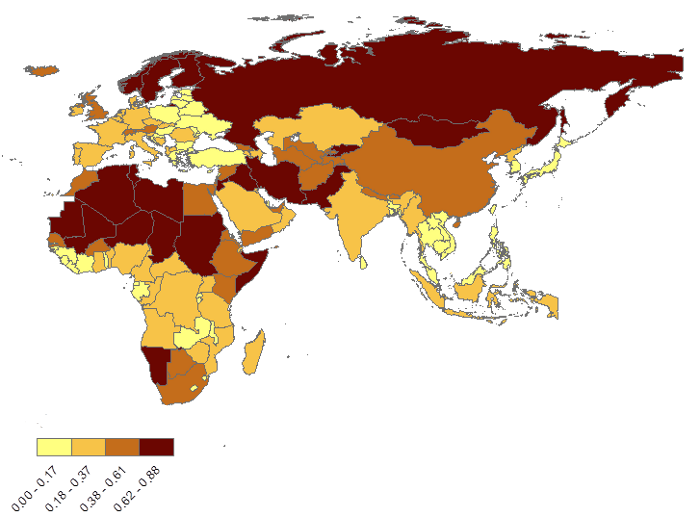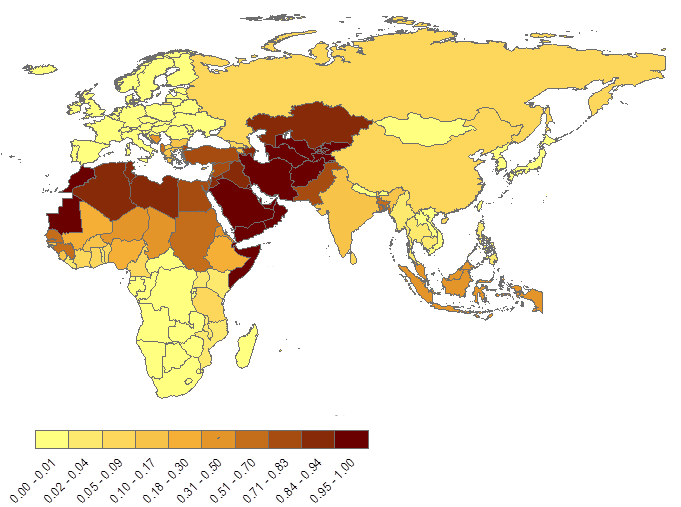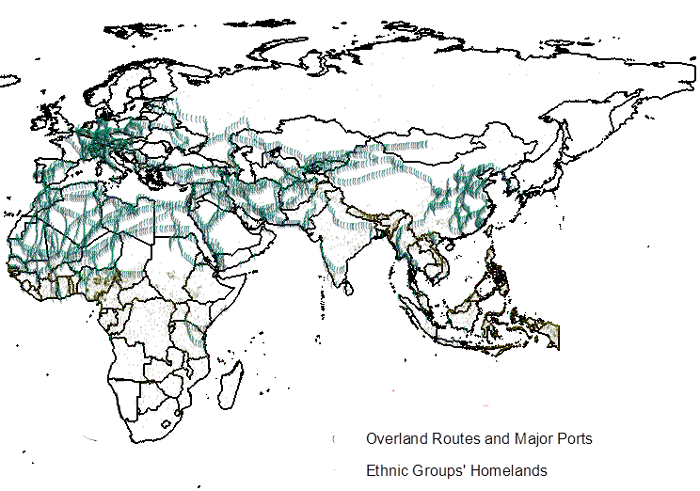Both the Arab Spring and the ongoing struggles in Syria are giving a new shape to the Muslim world. The power of the state is shifting from dictators to Islamic parties. Naturally, the international community is following this transition closely. Will centralised, religiously based political forces succeed in bringing together the heterogeneous population of the region? Will it put them on a path towards embracing adequate political and economic reforms?
What’s the impact of Islam on economics and politics?
Existing evidence regarding the impact of Islam on political and economic indicators is controversial. Some studies identify a negative relationship (cf. La Porta et al. 1997, Barro and McLeary 2003), whereas others show a positive or insignificant association (cf. Pryor 2007, Sala-i-Martin et al. 2004). Such correlations are interesting, but our understanding of the Muslim world will remain limited unless we identify the forces that gave rise to the adoption of Islam across as well as within countries. Our recent research provides a first step towards that goal (Michalopoulos, Naghavi and Prarolo 2012).
The role of 'geographic inequality' and trade in the adoption of Islam
Prominent Islamic historians and scholars (e.g. Ibn Khaldun 1377, Lapidus 2002, Berkey 2003, Lewis 1993) whose research focuses on where Islam was adopted emphasise the historical role of trade routes. Whether Islam was adopted can also be explained in part by geography. Building on this work, we provide a systematic exploration of the geographic factors that help explain its adherence within as well as across countries.
Geographical inequality
Our empirical investigation establishes that ‘geographic inequality’, meaning inequality in regional suitability for agriculture, is a fundamental determinant of contemporary Muslim adherence. It also shows that distance from pre-Islamic trade routes has a lingering effect on the contemporary distribution of Muslims with communities closer to preindustrial trade routes featuring a larger fraction of Muslim adherents. These findings provide a justification to the growing empirical literature that treats Muslim representation as predetermined with respect to contemporary economic and political indicators.
To conduct the empirical investigation we construct new data on:
- The regional suitability for farming.
- The pre-Islamic and pre-industrial trade routes in the Old World.
Combining these sources with information on Muslim adherence, we establish the following empirical regularities:
- First, countries with unequal endowments of regional agricultural potential and those located closer to pre-Islamic trade routes have higher Muslim representation, as shown in Figures 1, 2 and 3.
- Second, we focus on ethnic groups. Exploiting intra-country variation mitigates concerns related to the endogeneity of contemporary political boundaries.
Figure 1. Inequality in regional suitability for agriculture across the Old World
Figure 2. Percentage of Muslim population in AD 1900 in the Old World
Figure 3. Major trade routes in the Old World AD 600-AD 1800
The modern state's religious affiliation is, arguably, differentially affected by such things as state sponsorship of religion. As such, it is crucial to account for these state-specific histories. Unlike a cross-country setting, this is feasible with an 'intra-country-across-ethnic-groups' analysis. We can show, for instance, that ethnicities whose traditional homelands are characterised by unequal land endowments located closer to historical trade routes have higher Muslim adherence.
From 'geographic inequality' to economic equality
We start with the observation that, on the one hand, Islam surfaced in the Arabian Peninsula under conditions featuring an extremely unequal land quality distribution across regions. And, on the other hand, Islam surfaced in areas close to lucrative trade routes. As a result, when dwellers from the oases were attempting to cross the surrounding vast arid lands in pursuit of trade profits, they were facing threats to their livelihoods from nomadic groups. These encounters had the potential to bring trade flows to a halt, setting the stage for the emergence of a centralising force that featured redistributive rules. We argue that Islam was such a centralising force and that, accordingly, its economic tenets had to address inherent economic inequities across clans. This resulted in an economic doctrine that promoted poverty alleviation and redistribution, equitable inheritance rules and anti-usury laws.
The rise of Islamic economic principles
The conjecture that Islamic economic principles arose from the interplay between geographic inequality and trade opportunities generates an auxiliary prediction. Namely, the intensity of the adoption of Islam within unequally endowed groups should depend on their proximity to trade routes. This prediction is borne out by the data. In the empirical analysis, the interaction of ‘distance to trade routes’ and ‘geographic inequality’ enters with a negative and significant coefficient. This finding fits the narratives of Greif (2006), Insoll (2003) and Lewis (1993), who describe how a combination of highly developed Islamic legal codes with a single source of authority offered adherents and prospective adherents a strong commitment device. This commitment device was well suited to handle desert issues across communities who were engaged in trade but lacked the concentrated authority that was necessary to effectively impose duties or inflict penalties across heterogeneous groups.
Are Muslim groups really different? Evidence from African ethnicities
In an effort to explore whether Muslim groups have distinct societal and economic arrangements from non-Muslim groups, we turned to Murdock’s Ethnographic Atlas (1967), which codes pre-colonial cultural, societal and economic characteristics of 522 African ethnicities.
Similar to the pattern found for all groups in the Old World, African Muslim groups reside on geographically unequal territories that are close to pre-industrial trade routes. Our findings are consistent with the argument that geographic inequality dictates a specific subsistence pattern; we find that Muslim societies in Africa are characterised by a distribution of productive activities that are skewed towards pastoralism, that is, featuring little surplus-producing agriculture. Moreover, unlike non-Muslim groups for which the association between geographic and social inequality is strong, the tendency of an unequal geography to create social inequality within a group is muted for Muslim-majority ethnicities.
Islamic redistributive principles
But what economic traits characterise Muslim communities? Islamic doctrine prescribes an array of redistributive economic principles. Unfortunately, data on the extent of charity or usury laws within a group are not available. However, evidence does exists on types of pre-colonial inheritance systems, key aspects of Islamic economic principles (Kuran 2003, 2004). This evidence suggests that groups whose majority adheres to Islam are 34% and 24% more likely to have equal inheritance rules regarding movable and land property, respectively.
Islamic scholars such as Lapidus (2002) have suggested that nascent Islam aimed at creating a strong sense of community by imposing informal and formal punishments on its adherents, such as those related to ridda (apostasy). In this way, Islam effectively acted as a state-building force. It offered a means by which tribes could be unified through a common identity under one god that transcended clan and class divisions (Stearns et al., 2010). Is this facet of Islam evident in the anthropological record?
Fortunately, among the pre-colonial traits recorded by Murdock (1967) there is an entry describing whether a group believes or not in gods that are supportive of human morality. Anthropologists and evolutionary biologists have argued that the belief in moralising gods – gods who tell people what they should or should not do – was necessary to keep societies together by condemning infringements on other group members. Similarly, we argue that the presence of an unequal geography and proximity to trade opportunities intensified the need for cooperation among heterogeneous clans. Such cooperation could be achieved by adopting a religion which, besides the appropriate economic rules, would provide a coordination mechanism that penalised those who deviate from prescribed norms. With this in mind, it is not surprising to find that a 50% increase in Muslim adherence within a group increases the likelihood that a group believes in gods that dictate what should or should not be done by 40%. If anything, Christian and ethnoreligious groups are less likely to have harboured beliefs in a moralising god in the pre-colonial period.
The narrative suggests that Islam attempted to bring together heterogeneous tribal societies by appropriately crafting its economic principles. But was it successful in doing so? Is there evidence to suggest that Muslim groups are more politically centralised than non-Muslim groups? Muslim societies certainly have more levels of jurisdictional hierarchy enveloping their underlying communities. This pattern also suggests that Islam was a state-building force, gaining a hearing across tribal populations, thereby politically integrating them into more centralised units.
Conclusions
Our findings show that Islam flourished in very challenging geographical terrains. These terrains harboured inherently unequal economic opportunities and bred conflict. Any political platform that attempted to bring clashing populations together had to address these primordial inequities. Islam was certainly such a movement, and its spread is a prime example of how geography shapes a society’s institutional and societal arrangements.
References
Barro, R and R M McCleary (2003), “Religion and Economic Growth Across Countries,” American Sociological Review, 68(1).
Berkey, J P (2003), The Formation of Islam: Religion and Society in the Near East, 600-1800, Cambridge, Cambridge University Press.
Greif, A (2006), Institutions and the Path to Modern Economy: Lessons from Medieval Trade, Cambridge, Cambridge University Press.
Insoll, T (2003), The Archaeology of Islam in Sub-Saharan Africa, Cambridge and New York, Cambridge University Press.
Khaldun. I (1377), Muqaddimah: An Introduction to History, translated by Franz Rosenthal (1967), Princeton, NJ, Princeton University Press.
Kuran, T (2003), “The Islamic Commercial Crisis: Institutional Roots of Economic Underdevelopment in the Middle East”, Journal of Economic History, 63, 414—446.
Kuran, T (2004), Islam and Mammon: The Economic Predicaments of Islamism. Princeton, Princeton University Press.
Lapidus, I M (2002), A History of Islamic Societies, Cambridge, Cambridge University Press.
La Porta R, F L de Silanes, A Shleifer, and R Vishny (1997), “Legal Determinants of External Finance”, Journal of Finance, 52(3), 1131—1150.
Lewis, B (1993), The Arabs in History, 6th Edition. Oxford, Oxford University Press.
Michalopoulos S, A. Naghavi, and G Prarolo (2012), “Trade and Geography in the Origins and Spread of Islam”, NBER Working Paper, 18348.
Murdock, G. P. (1967), Ethnographic Atlas, Pittsburgh, PA, University of Pittsburgh Press.
Pryor, F L (2007), “The Economic Impact of Islam on Developing Countries”, World Development, 35(11), 1815—1835.
Stearns P N, M Adas, S B Schwarz and M J Gilbert (2010), World Civilizations: The Global Experience, 6th Edition. Upper Saddle River, NJ, Prentice Hall.









